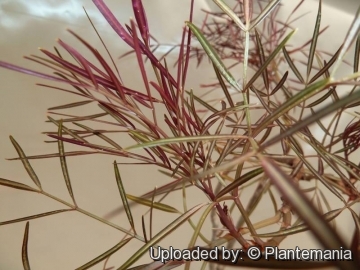
Cyphostemma mappia Photo by: © Plantemania
Cyphostemma mappia is heterophyllous, that is to say it has leaves of different types upon the same plant. Juvenile specimens have thin long and red leaves while in adult stage the leaves are oval and green.
Origin and Habitat: Cissus mappiaSN|33406]]SN|33406]] is endemic to Mauritius. Formerly abundant on the Pouce range, it is now very rare but still found in the old forests of the Great Bay and in the part of the island called Mapou, to which it has given its name. These trees seem extinct in many localities. It was exterminated from much of its natural range, but can still occasionally be found on extremely rocky slopes or outcrops in the higher mountains. It can be found on the mountain ranges of Trois Mamelles and Rempart, and in some of the remaining dry forests in the west of the island, especially around Magenta and Yemen.
Habitat and ecology: Dry and semi-dry forest, but especially in more exposed or mountainous areas. In exposed areas, it tends to be shorter and more robust - only a few meters tall. In more protected environments, it grows up to 10 meters in height. It produces flowers from January through May and sometimes they remain for as long as October.
Conservation status: Endangered.
Synonyms:
Common Names include:
ENGLISH: Mapou tree, Mauritian baobab
FRENCH (Français): bois mapou, mapou
Description: Mapou is the local name of Cissus mappiaSN|33406]]SN|33406]], a shrub or small tree 4-6 metres tall that can eventually reach a height of nearly 10 meters, and develop a vastly expanded, swollen, water-filled trunk. It looks like a minature baobab with a few sturdy branches easily breakable and in zigzag. By far it is the largest and most massive of the caudiciform or pachycaul members of the Vitaceae family. Apart from the Baobab (Adansonia digitataSN|102]]SN|102]]), this is without doubt one of the most spectacular pachycaul species. It bears compound deciduous leaves (odd number of leaflets). The leaflets are very variable. In adult specimen usually they are elliptic to oblong, light green with a pointed tip, to the contrary the juvenile leaflets can be very finely divided, thin, and red. The fruit look like small, red and furry grapes. As a case of "island gigantism", it is the only Cyphostemma species to attain the size of a large tree. It has also lost the vine-like tendrils of its genus, which falls within the greater Vitaceae (grapevine) family.
Stem: Bole (caudex), succulent, cylindrical, 2-7 m tall, entirely glabrous, with erect short branches without tendrils. Older branches thick, 6-10 mm in diameter, bark grey, smooth, young stems distinctively zigzag, fleshy, greenish. The wood is very soft and fleshy.
Leaves: Deciduous, 8-2 cm, pinnate (odd number of leaflets), bipinnate or 3-foliolate, petiole 2-3 cm. Leaflets succulent 3-4 cm long, (4-)12-14 nm wide, very variable in shape on the same plant (heterophyllous), elliptic, oblong, ovate or linear, tip acuminate, base cuneate, margins entire, sometimes denticulate in certain localities - the juvenile leaflets can be very long, thin and lighter red-coloured. Stipules oblong, 10-12 mm long.
Inflorescence: 6-10 cm long, glabrous. Peduncle 2-3 cm long.
Flowers. Cylindrical, 2-2.5 mm long, glabrous, greenish to pink or purple.
Fruits: Ovoid, 11-14 long, 6-8 mm in diameter, glabrous, fleshy, purple when ripe.
Seeds: Reniform, 7-8 long, 4-5 mm wide, smooth.
Bibliography: Major references and further lectures
1) John Gilbert Baker “Flora of Mauritius and the Seychelles: A Description of the Flowering Plants and Ferns of Those Islands” L. Reeve & Company, 1877
2) Sardanun Bundhoo “Goodlands and Her Neighbours” S. Bundhoo, 1989
3) Urs Eggli “Illustrated Handbook of Succulent Plants: Dicotyledons” Volume 2. Springer, 2002
4) Rachel Atkinson, Jean Claude Sevathian “A guide to the plants in Mauritius” Mauritian Wildlife Foundation, 01 january 2007
5) Ameenah Gurib-Fakim “An illustrated guide to the flora of Mauritius & the Indian Ocean Islands” Caractère Ltée, 2003
6) Wikipedia contributors. "Cyphostemma mappia." Wikipedia, The Free Encyclopedia. Wikipedia, The Free Encyclopedia, 26 Sep. 2016. Web. 26 Sep. 2016.
7) “ÉCOLOGIE : Le Bois Mapou un exemple d’évolution vers le gigantisme” ARTICLE PARU DANS LE MAURICIEN | 21 APRIL, 2012 <http://www.lemauricien.com/article/ecologie-bois-mapou-exemple-d%E2%80%99evolution-vers-gigantisme>
8) G.Rouillard “Les Plantes et Leur Histoire a L'ile Maurice”. Mauritius. 1999
 Cyphostemma mappia cotyledons. Photo by: © Plantemania
Cyphostemma mappia cotyledons. Photo by: © Plantemania Cyphostemma mappia juvenile foliage. Photo by: © Plantemania
Cyphostemma mappia juvenile foliage. Photo by: © PlantemaniaCultivation and Propagation: Cyphostemma mappiaSN|33405]]SN|33405]] is relatively slow-growing, but is increasingly used as a decorative ornamental for hotels and public landscaping in Mauritius. It is easily propagated by seed, or by cuttings which can be rooted in a shady environment.












